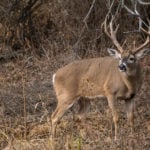LAST UPDATED: May 1st, 2015
Nothing in the hunting industry creates a frenzy among hunters quite like the opening day of deer season. Whether your season opens in August or October the anticipation is the same. An opening day buck is the dream of bowhunters across the nation. These five factors can help your opening day dream come true.
1. Gain Access Early
Access to hunting property is seemingly harder to come by every year. Talk to any bowhunter and you’ll most likely hear about the “good old days” when nearly any landowner would allow access to prime hunting land. Unfortunately, those days are gone. Today, we all have to work harder to find good areas to fill tags with. Having hunting ground is an absolute must (obviously) but the more access you have, the better your odds at harvesting an opening day bruiser.
With good hunting property becoming harder to find, waiting until the last minute to “confirm” your hunting area is available may be too late.
Securing as much hunting property as possible prior to the opener is one of the best “insurance policies” you have for filling an early season deer tag. Some lucky hunters harvest early season deer every year on a 10 acre plot. However, the majority of hunters aren’t that lucky, and let’s face it, some years a trophy buck just might not be in the area. When you have options, your chances of success increase exponentially. Hopefully by this time of the year you’ve traded work, money or your pinky finger for a place to hunt. If not… you have some serious work to do.
2. Stay On-the-Ball with your property
The early season offers bowhunters opportunities that can be lost within a week or two of the opener. For the majority of the United States deer are in their summer patterns during this time; which consists of two things, bedding and feeding. Sure, deer do this all year but when you are targeting a specific buck and you don’t have to deal with rut phases, your job is a whole lot simpler. Patterning anything buck during the rut is almost impossible so take advantage of the early season when deer are traveling from bed to feed in an almost predictable manner.
During the early-season food sources and travel routes will change dramatically. The bowhunter who recognizes and prepares for this will be more likely to score.
Keep in mind though that this early season advantage may last only a very short time. There are a few reasons for this. First, the majority of deer killed in the early season are on or near food sources such as soybeans. Beans are an excellent food source for whitetails and provide outstanding scouting opportunities as you can actually see deer feeding in the evenings. Unfortunately, the soybeans mature and are harvested right around the opening day of deer season in many states. If possible, it’s important to know when the farmers or landowners are harvesting crops, there is little that is more disheartening than arriving at your property on opening day to find the beans harvested or the alfalfa cut. Staying on-the-ball, or up-to-date on food offerings is key to success.
3. Trail Camera Scouting
Today, trail cameras are an incredible tool but they weren’t readily available to earlier generations of deer hunters. As hunting ground has become harder to acquire, many hunters are forced to travel for hours to their hunting ground. Having a trail camera in the area to capture daily events while you are hard at work is very advantageous.
Don’t over look the importance of using scouting cameras to keep up on feeding and bedding habits and when they change.
During the early season, when deer are still using a summer travel pattern, you can utilize a camera in order to determine what time and which direction deer are moving in. Not only does it help to understand where deer are going, you can also plan your hunts according to a particular wind when you know what trail they are using.
4. Scouting in Real Time
While trail cameras are great resource for hunters, “on-site” scouting cannot be replaced. Although many hunters rely heavily on trail-cameras to tell them what type of deer is on their property, they may be missing some important information if scouting is limited strictly to camera surveillance. For example, one late summer evening spent over-looking a food plot with a set of binoculars can tell you things that a summer’s worth of trail camera photos will not.
Sometimes a day spent “scouting” can be more productive than actually hunting.
Not only can you watch from a distance, but you also keep from disturbing the deer on your hunting ground. Seeing a photo isn’t quite as exciting as laying your own eyes on that velvet monster. Scouting is a great opportunity to involve kids and family in the hunt as well.
5. Shooting Preparation
Shooting preparation is another factor that should never be overlooked. Many hunters pick up their bow the week before opening day, fling a few arrows and head to the woods. This is never a good idea. Even though you may be just fine while shooting your block target in the back yard, a live animal is nowhere near the same.
For example, holding your draw for long periods of time may be necessary when a buck comes into view. If your bow muscles aren’t in shape or used to that kind of situation that buck may live to see another day. A better approach is to shoot often and practice under real-world situations. Perhaps try to hold your bow at full draw for a full minute and then shoot. Or maybe shoot at longer distance than you plan to shoot at an animal. Shooting at longer distances will make the short shots fell more like a chip shot. Also, before the season starts, make sure your bow is in good shape. Make sure the strings and cables are waxed and that all nuts and bolts are tight. Taking these precautions before the season will ensure your equipment is ready to roll when the gate drops on the early season.
Just because the season has started doesn’t mean that shooting practice should end.
There is simply no substitute for time in the stand. However, for most bowhunters, hunting all day, every day is not an option. The majority of bowhunters plan to take time off in late October and November when bucks are seemingly on their feet and on the move. However, if hunters would spend the same number of days in the woods in the early season, chances are they would be just as successful and have some free time during the rut.
Being able to focus your efforts on summer-patterned deer, as opposed to the random behavior of November whitetails, is worth a little of your time and certainly increases your odds of success. Don’t overlook the warmer temperatures and longer days of the early season when planning your hunting vacation. Best of luck!

 By
By 




